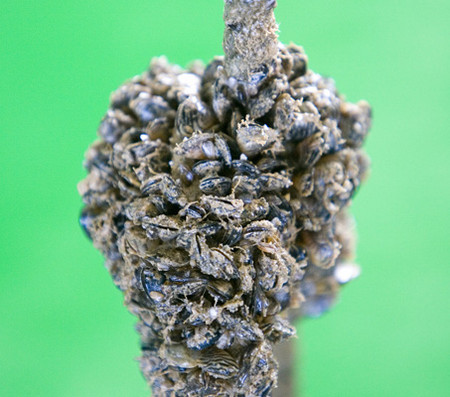Quaggas in Lake Mead being fruitful, expert says
The number is 3 trillion and counting.
That's how many quagga mussels scientists think have invaded Lake Mead's Boulder Basin since they were first discovered there two years ago.
A UNLV expert on quaggas said Wednesday that the population explosion is occurring at an alarming rate at various depths down to 355 feet. They thrive best on hard surfaces based on observations in hard and soft sediments, said David Wong, an expert on the pesky mollusks who was recruited from Wisconsin to assess the problem for the university.
Abundant calcium in the water and relatively warm temperatures also help fuel the population growth, he said.
That's why government agencies including the National Park Service are teaming with the university and its research arm, Desert Research Institute, to launch a plan to track and reduce impacts from massive colonies of the fingernail-size mussels.
A goal of the effort is to establish more than 50 sampling sites in the lake with results of the first studies expected in about a year, he said.
"We are going to focus on two issues: the quagga mussels themselves and their impact," Wong said.
Based on the damage quaggas along with zebra mussels caused in the Great Lakes region, Lake Mead's mussels are beginning to impact the lake's ecosystem at a faster rate while at the same time clogging water pipelines and encrusting boats and marine equipment. Already the costs for maintaining water intakes, marine structures and watercraft in Lake Mead National Recreation Area are more than $1 million yearly.
Their discovery in Boulder Basin on Jan. 6, 2007, was the first known occurrence of the species in the Western United States.
Since then, population numbers jumped from 47.8 billion in 2007 to 2.9 trillion in Boulder Basin alone last year.
"You see there is a huge difference between these two years," Wong wrote in an e-mail Wednesday. "The key reason is because there are a lot of new juveniles in 2008 because of the explosive reproduction and growth."
Using raw data from various depths, he calculated how many live in hard and soft sediments. Most, 86 percent, are found in hard sediments and surfaces.
What the figures don't show is how many more mussel larvae are living in the lake's water that are soon to join the ranks of adults and juveniles.
With the right mix of food, calcium, dissolved oxygen and water temperature, quaggas can reproduce six times a year in lakes on the Lower Colorado River system, with a single female laying as many as 1 million eggs each time, scientists estimate.
Biologists think quaggas arrived at Lake Mead by hitchhiking in bilge water or equipment of a boat from the Midwest. They have spread rapidly in the lake and downstream to lakes Mohave and Havasu and waterways in southern and central California.
Quagga mussels are native to Ukraine's Dneiper River drainage. Like the zebra mussel, they were transported to the Great Lakes in the ballast water of ships in the mid-1980s.
Contact reporter Keith Rogers at krogers@reviewjournal.com or 702-383-0308.
TAHOE STUDIED
RENO -- Lake Tahoe's economy could lose millions of dollars in taxes and tourism revenue if invasive mussels become established in the lake's famed blue waters, according to a new report.
The report prepared by the U.S. Army Corps of Engineers estimated that the Tahoe economy could suffer an annual loss of $22 million because of lost tourism, declining property values and maintenance costs associated with the mollusks, the Reno Gazette-Journal reported.
The mollusks could forever alter the sensitive ecosystem, clog intakes, encrust boats and docks and cover now-pristine beaches with sharp, smelly shells, experts say, and might spread down the Truckee River to Pyramid Lake north of Reno.
THE ASSOCIATED PRESS

















